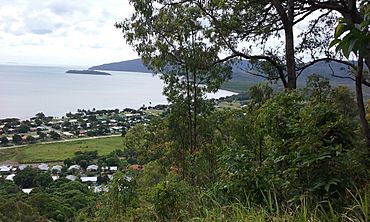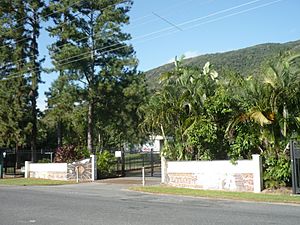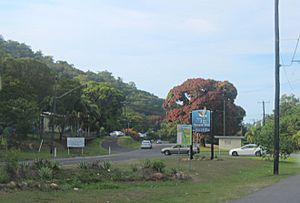Yarrabah, Queensland facts for kids
Quick facts for kids YarrabahQueensland |
|||||||||||||||
|---|---|---|---|---|---|---|---|---|---|---|---|---|---|---|---|

Town of Yarrabah, 2020
|
|||||||||||||||
| Population | 2,505 (2021 census) | ||||||||||||||
| • Density | 16.058/km2 (41.59/sq mi) | ||||||||||||||
| Established | 1892 | ||||||||||||||
| Postcode(s) | 4871 | ||||||||||||||
| Area | 156.0 km2 (60.2 sq mi) | ||||||||||||||
| Time zone | AEST (UTC+10:00) | ||||||||||||||
| Location |
|
||||||||||||||
| LGA(s) | Aboriginal Shire of Yarrabah | ||||||||||||||
| State electorate(s) | Mulgrave | ||||||||||||||
| Federal Division(s) | Kennedy | ||||||||||||||
|
|||||||||||||||
Yarrabah is a coastal town in Queensland, Australia. It's a special Aboriginal community where the traditional name is Jarrabah in the Gunggandji language. In 2021, about 2,505 people lived in Yarrabah. It's part of the Aboriginal Shire of Yarrabah.
About Yarrabah
Where is Yarrabah?
Yarrabah is a town located on Cape Grafton in Queensland. It is about 51.5 kilometres (32 miles) by road from Cairns CBD. Even though it's only 10 kilometres (6 miles) in a straight line, mountains and an inlet of the Coral Sea separate it from Cairns.
A Look at Yarrabah's Past
How Yarrabah Started
In 1892, an Anglican church missionary named Ernest Gribble started visiting the Aboriginal people living in the Yarrabah area. He wanted them to move to a mission he was setting up. With help from the tribe's leader, Menmuny, the community moved to the mission, which became known as Yarrabah Community. The mission officially began in 1893. Over time, many people, including some South Sea Islanders, were moved to Yarrabah from their original homes.
Changes Over Time
In 1957, people in Yarrabah went on strike to protest bad working conditions and poor food. The church removed the leaders, and many others left. A few years later, the Government of Queensland took over the mission.
In 1965, an advisory council was created. This council allowed Aboriginal people to give "advice" to the government, but they didn't have real power. The government still controlled many parts of their lives.
Gaining Self-Control
On October 27, 1986, the community received special land rights. This meant they could have their own self-governing Aboriginal Community Councils. These councils had more power and control over the land. In 2005, the Council became an "Aboriginal Shire." This gave it the authority of a local government.
Yarrabah has also hosted important meetings. In 2007, the Queensland Government held its first ever Cabinet meeting in an indigenous Australian community right here in Yarrabah. Later that year, the Howard Government chose Yarrabah for a new housing and welfare plan.
Who Lives in Yarrabah?
In 1952, about 630 Indigenous people lived in Yarrabah.
The 2016 census showed that 2,559 people lived in Yarrabah. Most of these people, 97.4%, identified as Aboriginal or Torres Strait Islander. The average age of people in Yarrabah was 23, which is younger than the national average of 38. Many people in Yarrabah work for the local government or in social services.
Most people in Yarrabah, 84.8%, speak only English at home. Another language spoken is Kriol. A unique language called Yarrabah Creole is also spoken here, which is considered a dialect of English.
Learning in Yarrabah
Yarrabah State School is a government school for primary and secondary students (from Early Childhood to Year 10). It also has a special education program. In 2022, the school had 465 students. Many of the staff are Indigenous.
The school has three different campuses:
- The Early Childhood and Prep campus is on Workshop Street.
- The primary school (Years 1-6) campus is on Gribble Street.
- The secondary campus (Years 7-10) is on Back Beach Road.
For students who want to continue to senior years (Year 11-12), the closest school is Gordonvale State High School in Gordonvale. There is a free school bus to Gordonvale, which is the only public transport for Yarrabah residents. Years ago, a ferry used to take students to school in Cairns, but that service is no longer used.
Yarrabah also has a public library called an Indigenous Knowledge Centre (IKC). It offers computers, internet access, and a Homework Centre. It also helps people who want to become teachers through a program with James Cook University.
Life in Yarrabah
Services and Facilities
Ergon Energy provides electricity to the main parts of Yarrabah. However, some areas further out, like Wungu, Back Beach, and Turtle Bay, use power generators for electricity. These areas sometimes have power blackouts, especially during the wet season.
Yarrabah has a health centre that helps with emergencies and general medical care. It is open 24 hours a day. There is also a police station in the town.
Shops and Community Spots
Yarrabah has a small supermarket run by local people. There are also two take-away food shops, a bakery, a drive-in pub, and a service station. For most other shopping, people travel to Gordonvale, Edmonton, or Cairns. The road to Yarrabah is sealed, so it can be used all year.
The community publishes its own newsletter called Yarrabah News every month. There is also a police citizens youth club in the town.
Yarrabah has a long history with brass bands, dating back to 1901. The band was restarted in 2013 and now performs at the annual Yarrabah Band Festival.
The Indigenous Knowledge Centre
The Yarrabah Aboriginal Shire Council runs an Indigenous Knowledge Centre (IKC) library. It opened in 2015 and offers learning opportunities for the community. The centre was built with funding from the Queensland Government. Yarrabah has had a library service since 1984.
Things to See and Do
Yarrabah Menmuny Museum
The Yarrabah Menmuny Museum opened in 1996. It is named after Menmuny, a local tribe leader from the late 1800s. He was also known as 'King John' Menmuny. The museum is located in the Jilji area.
Yarrabah Band Festival
The Yarrabah Band Festival is held every year around October. It's a popular event that attracts about 4,000 people.
Getting Around Yarrabah
Yarrabah is connected by a sealed road to Gordonvale, Edmonton, and Cairns.
In the past, when there were no sealed roads, a ferry service called a 'flatty' took school children between Yarrabah and Cairns. A new wharf project started in 2021. When it's finished, it's expected that regular water transport will return, making it easier to travel the 11 kilometres by sea to Cairns.
Sometimes, you might see young people riding brumbies (wild horses) in the area without saddles.
Images for kids



















